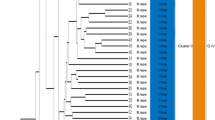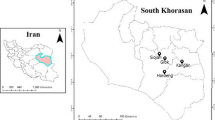Abstract
RAPD markers analysis was performed to investigate genetic relatedness among nine sterile (A), maintainer lines (B), and male parents (C) of onion. Initially, 180 arbitrary decamer primers were screened; of these 20 primers were selected which yielded 812 bands, 45.34% of which were found to be polymorphic. Squared-Euclidean Distance matrix revealed a minimum genetic distance between the genotypes MS 48A and MF 65C and a maximum genetic distance between the genotypes MLT 84C and MF 65B. Cluster analysis grouped the nine onion genotypes into two major clusters. The first cluster consisted of two male sterile groups, i.e. MS-65 (Arka Lalima) and MS-48 (Arka Kirthiman) of single bulb onions. The second cluster consists of MLT (Multiplier) group. PCA re-confirmed the results of the dendrogram, revealing the precision in estimation of genetic relatedness among the genotypes tested. None of the primers produced unique banding patterns to distinguish all nine genotypes. This information about genetic relatedness among the nine genotypes would be better utilized in further onion breeding programs.
Similar content being viewed by others

References
Bradeen JM, Havey MJ. 1995. Randomly amplified polymorphic DNA in bulb onion and its use to assess inbred integrity. J. Amer. Soc. Hort. Sci. 120: 752–758
Carlson JE, Tulsieram LK, Rutledge R. 1991. Segregation of random amplified DNA markers in F1 progenies of conifers. Theor. Appl. Genet. 83: 194–200
FAO. 2008. Agrostat database, Available at http://faostat.fao.org/
Hanelt P. 1990. Taxonomy, evolution and history. In HD Rabino witch, JL Brewster, eds. Onions and Allied Crops, Vol. I., Botany, Physiology and Genetics. CRC Press, Boca Raton, Florida
Havey MJ, King JJ, Bradeen JM, Bark OH. 1996. Molecular markers and mapping in bulb onion, a forgotten monocot. Hort. Sci. 31: 1116–1118
Kim C, Lee E, Park H, Jang Y, Choi I, Krawetz SA 1989. The polymerase chain reaction: opportunities for agriculture.Agric. Biotechnol. News Info. 1: 897–902
Le Thierry MD, Panaud O, Robert T, Richroch A. 1997. Assessment of genetic relationships among sexual and asexu al forms of Allium cepa using morphological traits and RAPD markers. Heredity 78: 403–409
Melchinger AE, Lee M, Lamkey KR, Woodman WW. 1990a. Genetic diversity for restriction fragment length polymorphisms, relation to estimated genetic effects in maize inbreds. Crop. Sci. 30: 1033–1040
NHB 2009. In B Kumar, NC Mistry, B Singh, CP Gandhi, eds, Indian Horticulture Database — 2009. National Horticulture Board, Gurgaon, New Delhi. http://nhb.gov.in/database-2009.pdf
Roxas VP, Peffley EB. 1992. Short-day onion varietal identification using molecular (RAPD) markers. Allium Improvement Newsl. 2, 15–17
Shastri JL. 1995. Garuda Purana. In JL Shastri, GP Bhatt, GV Tagare, eds, Ancient Indian Tradition and Mythology, Vol. 12, Motilal Banarsidass Publishers, Delhi, p 30
Sokal RR, Sneath PHA. 1973. Principles of Numerical Taxonomy, WH Freeman and Co., San Francisco, USA
Tanikawa T, Takagi M, Ichii M. 2002. Cultivar identification and genetic diversity in onion (Allium cepa L.) as evaluated by random amplified polymorphic DNA (RAPD) analysis. J. Jpn. Soc. Hort. Sci. 72: 249–251
Van Loon V. 2003. Charaka Samhita. Handbook on Ayurveda. Volume I. www.ayurvedaberkeleycom/.../Charaka’s.../Charaka-Samhita-2003-rev2_Vol_I.pdf 26
Virmani SS. 1994. Prospects of hybrid rice in the tropics and subtropics. In S Virmani, ed, Hybrid Rice Technology: New Developments and Future Prospects, pp 7–19. Int. Rice Res. Inst. Manila Philippines
Ward, JH 1963. Hierarchic grouping to optimize an objective function. J. Amer. Statistical Assoc. 58: 236–239
Wilkie SE, Isaac, PG, Robert JS. 1993. Random Amplified Polymorphic DNA (RAPD) markers for genetic analysis in Allium. Theor. Appl. Genet. 86: 497–504
Williams JGK, Kubelik A, Livak KJ, Rafalski JA, Tingey SV. 1990. DNA Polymorphisma amplified by arbitrary primers are useful as genetic markers. Nuc. Acids Res. 18: 631–635
Woodward PW. 1996. Garlic and Friends: The History, Growth and Use of Edible Alliums, Hyland House, Melbourne, pp 2–22.
Author information
Authors and Affiliations
Corresponding author
Rights and permissions
About this article
Cite this article
Shivnanajappa, D., Chinnappareddy, L.R.D., Gowda, V. et al. The genetic relatedness analysis of male sterile and their maintainer lines of onion (Allium cepa L.) by using RAPD primers. J. Crop Sci. Biotechnol. 16, 29–33 (2013). https://doi.org/10.1007/s12892-011-0013-7
Received:
Revised:
Accepted:
Published:
Issue Date:
DOI: https://doi.org/10.1007/s12892-011-0013-7



